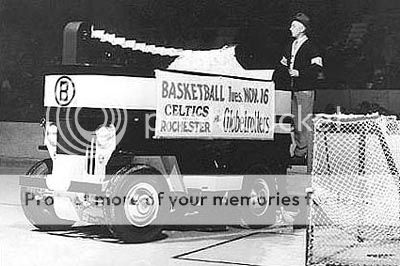Fluto travels to Canada to try to sell fans than Olympia is better than Zamboni
When is a Zamboni not a Zamboni? Under the hood of an...
In 1954, the Bruins became the first NHL team to purchase Zamboni’s Model E. During the 2013-14 season, the team switched to Olympia. According to Schlupp, the Bruins were not satisfied with the performance of their Zamboni ice resurfacers. They are one of five NHL clubs (Carolina, St. Louis, Vancouver and Washington are the others) to use Olympia ice resurfacers. Warrior Ice Arena, the Bruins’ practice facility, also uses Olympias.
On an Olympia, the blade that scrapes the ice is attached by a bolt. Zamboni uses springs to attach its blade. Olympia runs on a Power Solutions International engine. Zamboni uses Kubota in the US and Mitsubishi in Canada.
There are other differences throughout the machines. But to the average onlooker, a Zamboni and an Olympia appear alike. Machines that share similar appearances follow the same principles: scrape the ice, store the snow and lay down fresh water, all while looking like enlarged versions of children’s toys.
“They’re a little different,” said Jason Piche, operations manager at Warrior Ice Arena. “But they all basically do the same thing. They get you from Point A to Point B, and they both make the ice.”
Diagram: How Olympia cleans the ice

1. Driver: An experienced driver steers with his or left hand and operates the controls — lifting the blade, putting down the water — with the right hand. According to Don Schlupp, Resurfice director of product development, it takes approximately 20 hours of on-ice training for a driver to become comfortable on an ice resurfacer. Resurfice provides a recommended resurfacing pattern for each driver to execute depending on the rink, usually starting along the boards.
2. Conditioner: Where the magic happens. An 80- or 84-inch blade scrapes the ice. Cold wash water is applied to turn shavings into slush, which is pressed down to fill skate grooves. Resurfacing water, usually heated to 180 degrees in NHL rinks, is then laid down.
3. Engine: Olympia uses a 4.3-liter V-6 Power Solutions International engine. It is mated with a Bosch Rexroth transmission. Top speed is around 7.5 miles per hour.
4. Box: Where the shavings are stored. A typical box is 106 cubic feet. Two augers shoot the shavings into the box. After a resurfacing, the box usually tilts forward to dump out the snow. Between periods of an NHL game, both ice resurfacers typically exit the ice with full boxes.
When is a Zamboni not a Zamboni? Under the hood of an...
In 1954, the Bruins became the first NHL team to purchase Zamboni’s Model E. During the 2013-14 season, the team switched to Olympia. According to Schlupp, the Bruins were not satisfied with the performance of their Zamboni ice resurfacers. They are one of five NHL clubs (Carolina, St. Louis, Vancouver and Washington are the others) to use Olympia ice resurfacers. Warrior Ice Arena, the Bruins’ practice facility, also uses Olympias.
On an Olympia, the blade that scrapes the ice is attached by a bolt. Zamboni uses springs to attach its blade. Olympia runs on a Power Solutions International engine. Zamboni uses Kubota in the US and Mitsubishi in Canada.
There are other differences throughout the machines. But to the average onlooker, a Zamboni and an Olympia appear alike. Machines that share similar appearances follow the same principles: scrape the ice, store the snow and lay down fresh water, all while looking like enlarged versions of children’s toys.
“They’re a little different,” said Jason Piche, operations manager at Warrior Ice Arena. “But they all basically do the same thing. They get you from Point A to Point B, and they both make the ice.”
Diagram: How Olympia cleans the ice

1. Driver: An experienced driver steers with his or left hand and operates the controls — lifting the blade, putting down the water — with the right hand. According to Don Schlupp, Resurfice director of product development, it takes approximately 20 hours of on-ice training for a driver to become comfortable on an ice resurfacer. Resurfice provides a recommended resurfacing pattern for each driver to execute depending on the rink, usually starting along the boards.
2. Conditioner: Where the magic happens. An 80- or 84-inch blade scrapes the ice. Cold wash water is applied to turn shavings into slush, which is pressed down to fill skate grooves. Resurfacing water, usually heated to 180 degrees in NHL rinks, is then laid down.
3. Engine: Olympia uses a 4.3-liter V-6 Power Solutions International engine. It is mated with a Bosch Rexroth transmission. Top speed is around 7.5 miles per hour.
4. Box: Where the shavings are stored. A typical box is 106 cubic feet. Two augers shoot the shavings into the box. After a resurfacing, the box usually tilts forward to dump out the snow. Between periods of an NHL game, both ice resurfacers typically exit the ice with full boxes.




